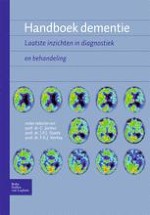2009 | OriginalPaper | Hoofdstuk
18 Ziekte van Alzheimer
Auteurs : Ph. Scheltens, W.M. van der Flier, A.M. Rozemuller, Y.A.L. Pijnenburg
Gepubliceerd in: Handboek dementie
Uitgeverij: Bohn Stafleu van Loghum
Kernpunten
-
De ziekte van Alzheimer is de meest voorkomende vorm van dementie.
-
De klinische diagnose wordt gesteld op basis van (hetero)anamnese, gedragsobservatie, lichamelijk/neurologisch en cognitief onderzoek, en zo nodig aanvullend beeldvormend en liquoronderzoek.
-
De kenmerkende neuropathologische veranderingen zijn (amyloïd en neuritische) plaques, neurofibrillaire tangles, synapsverlies en geactiveerde microglia.
-
Psychosociale behandeling is ondersteunend en gericht op de zorgbehoefte van de patiënt en diens omgeving. Medicamenteuze behandeling is gericht op het verbeteren/stabiliseren van de cognitieve problemen.
